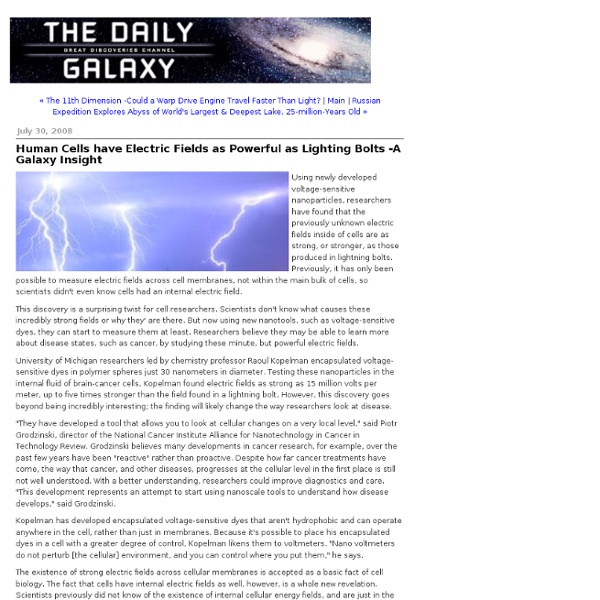Flowers get an electrifying buzz out of visiting bees - life - 21 February 2013
Plants could turn out to be one of the more chatty organisms. Recent studies have shown they can communicate with a surprising range of cues. Now it turns out they could be sending out electrical signals, too.
Quantum 'weirdness' used by plants, animals - Technology & Science
Birds like the European robin have an internal compass which appears to make use of a phenomenon called quantum entanglement. ((Vasily Fedosenko/Reuters)) Bird navigation, plant photosynthesis and the human sense of smell all represent ways living things appear to exploit the oddities of quantum physics, scientists are finding. Quantum mechanics is the branch of physics dealing with the strange behaviour of very tiny things like elementary particles and atoms, and is extremely different from the physics that humans experience every day.
UCI, fellow chemists find a way to unboil eggs
Irvine, Calif., Jan. 23, 2015 – UC Irvine and Australian chemists have figured out how to unboil egg whites – an innovation that could dramatically reduce costs for cancer treatments, food production and other segments of the $160 billion global biotechnology industry, according to findings published today in the journal ChemBioChem. “Yes, we have invented a way to unboil a hen egg,” said Gregory Weiss, UCI professor of chemistry and molecular biology & biochemistry. “In our paper, we describe a device for pulling apart tangled proteins and allowing them to refold. We start with egg whites boiled for 20 minutes at 90 degrees Celsius and return a key protein in the egg to working order.”
Unusual quantum effect discovered in earliest stages of photosynthesis
Quantum physics and plant biology seem like two branches of science that could not be more different, but surprisingly they may in fact be intimately tied. Researchers at the U.S. Department of Energy's (DOE) Argonne National Laboratory and the Notre Dame Radiation Laboratory at the University of Notre Dame used ultrafast spectroscopy to see what happens at the subatomic level during the very first stage of photosynthesis.
Scientists Identify Gene Required for Nerve Regeneration
A gene that is associated with regeneration of injured nerve cells has been identified by a team of researchers led by Prof Melissa Rolls of Penn State University. In fruit flies with two normal copies of the spastin gene, a team of scientists led by Prof Melissa Rolls of Penn State University found that severed axons were able to regenerate. However, in fruit flies with two or even only one abnormal spastin gene, the severed axons were not able to regenerate (Melissa Rolls / Penn State University) The team has found that a mutation in a single gene can entirely shut down the process by which axons – the parts of the nerve cell that are responsible for sending signals to other cells – regrow themselves after being cut or damaged. “We are hopeful that this discovery will open the door to new research related to spinal-cord and other neurological disorders in humans,” said Prof Rolls, who co-authored a paper published online in the journal Cell Reports.
New evidence that plants get their energy using quantum entanglement
The fact that biological systems can exploit quantum effects is quite astounding. No it is not, not even remotely.There is literally no possible way that photosynthesis could take place without involving quantum physics. This particular exploit is really neat, of course, but far too much as been made of how mystical or ungraspable quantum physics is.
New wonder drug matches and kills all kinds of cancer — human testing starts 2014
Stanford researchers are on track to begin human trials of a potentially potent new weapon against cancer, and would-be participants are flooding in following the Post’s initial report on the discovery. The progress comes just two months after the groundbreaking study by Dr Irv Weissman, who developed an antibody that breaks down a cancer’s defense mechanisms in the body. A protein called CD47 tells the body not to “eat” the cancer, but the antibody developed by Dr Weissman blocks CD47 and frees up immune cells called macrophages — which can then engulf the deadly cells. The new research shows the miraculous macrophages effectively act as intelligence gatherers for the body, pointing out cancerous cells to cancer-fighting “killer T” cells. The T cells then “learn” to hunt down and attack the cancer, the researchers claim.
You’re powered by quantum mechanics. No, really…
Every year, around about this time, thousands of European robins escape the oncoming harsh Scandinavian winter and head south to the warmer Mediterranean coasts. How they find their way unerringly on this 2,000-mile journey is one of the true wonders of the natural world. For unlike many other species of migratory birds, marine animals and even insects, they do not rely on landmarks, ocean currents, the position of the sun or a built-in star map. Instead, they are among a select group of animals that use a remarkable navigation sense – remarkable for two reasons.



